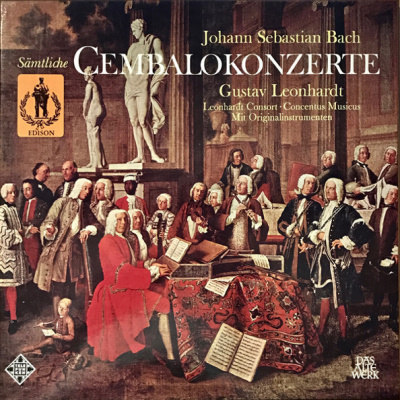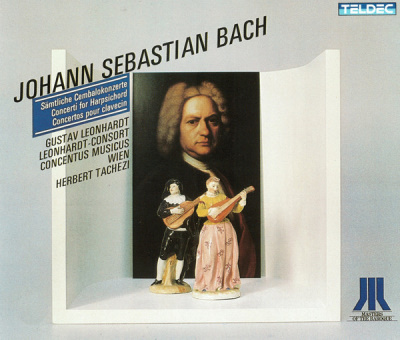 |
|
1 LP -
SAWT 9424-B - (p) 1963
|
 |
| 1 LP -
SAWT 9424-B - (p) 1963 |
 |
| 1 LP -
6.41046 AS - (p) 1963 |
 |
| 5 LPs -
SCA 25022-T/1-5 - (c) 1972 |
 |
| 2 CDs -
8.35778 XD - (c) 1989 |
|
| CEMBALOKONZERTE |
|
|
|
|
|
|
|
|
|
| Johann Sebastian
BACH (1685-1750) |
Konzert
für zwei Cembali c-moll, BWV 1062 -
zwei Violinen, Viola und Continuo
|
I:
EM* | II: GL**
|
|
14' 42" |
|
|
-
(Allegro)
|
|
3' 44" |
|
A1
|
|
- Andante
|
|
6' 07" |
|
A2
|
|
-
Allegro assai
|
|
4' 51" |
|
A3 |
|
Konzert
für zwei Cembali c-moll, BWV 1060 -
zwei Violinen, Viola und Continuo |
I:
GL** | II: EM *
|
|
14' 02" |
|
|
-
Allegro
|
|
5' 02" |
|
A4 |
|
-
Adagio |
|
5' 09" |
|
B1 |
|
-
Allegro
|
|
3' 51" |
|
B2 |
|
Konzert
für vier Cembali a-moll, BWV 1065 -
zwei Violinen, Viola und Continuo |
I:
EM* | II: GL*** | III: JvW**** | IV:
AU**
|
|
10' 17" |
|
|
-
(Allegro) |
|
4' 35" |
|
B3 |
|
-
Largo |
|
2' 10" |
|
B4 |
|
-
Allegro
|
|
3' 32" |
|
B5 |
|
|
|
|
|
|
Eduard
MÜLLER, Cembalo
Gustav LEONHARDT, Cembalo
Janny van WERING, Cembalo
Anneke UITTENBOSCH, Cembalo
|
DAS
LEONHARDT-CONSORT
- Marie Leonhardt, Antoinette van den
Hombergh, Violine
- Wim ten Have, Viola (BWV 1062, 1065)
- Lodewijk de Boer, Viola (BWV 1060)
- Dijck Koster, Violoncello
- Fred Nijenhuis, Baß
|
Instrumente:
- Cembalo (R. Rück, nach C. A. Gräbner,
Dresden, 1782, kopiert) *
- Cembalo (M. Skowroneck, nach J. D.
Dulcken, Antwerpen, kopiert) **
- Cembalo (J. & A. Kirckman, London,
1755) ***
- Cembalo (J. C. Neupert, 1932) ****
- Violine (Jakob Stainer, 1676)
- Violine (Klotz, 18. Jahrh.)
- Viola (Giovanni Tononi, 17. Jahrh.)
- Viola (deutsch, 18. Jahrh.)
- Violoncello (Giovanni Battista [II]
Guadagnini, 1749
- Kontrabaß (deutsch, 18. Jahrh.)
Alle Instrumente in Barockmensur
Stimmung ein Halbton unter normal
|
|
|
|
|
|
Luogo
e data di registrazione |
|
Amsterdam (Holland) -
22/27 Ottobre 1962
|
|
|
Registrazione: live
/ studio |
|
studio |
|
|
Producer |
|
Wolf Erichson
|
|
|
Prima Edizione LP |
|
Telefunken "Das Alte
Werk" | SAWT 9424-B (Stereo) - AWT
9424-C (Mono) | 1 LP - durata 39'
01" | (p) 1963 | ANA
Telefunken "Das Alte Werk" | SAWT
9424-B | 1 LP durata 39' 01" | (p)
1963 | ANA | Riedizione
Telefunken
"Das Alte Werk" | 6.41046 AS | 1
LP - durata 39' 01" | (p) 1963 |
ANA | Riedizione
Telefunken "Das Alte Werk" | SCA
25022-T/1-5 | 5 LPs - durata
212' 39" | (c) 1972 | ANA | (Sämtliche
Cembalokonzerte)
|
|
|
Edizione CD |
|
Teldec Classics |
LC 3706 | 8.35778 XD | 3 CDs -
durata 76' 42" - 72' 00" - 63'
57" | (c) 1989 | ADD |
(Sämtliche Cembalokonzerte) |
|
|
Cover
|
|
- |
|
|
Note |
|
-
|
|
|
|
|
Bach's
harpsichord concertos were
composed at Leipzig where,
beside his appointment as
cantor at the St. Thomas
School, from 1729 to 1736 he
had taken on the direction
of the Telemann Music
Society and of the Collegium
Musicum of the University.
He must have had excellent
keyboard performers at his
disposal, for apart from the
fact that he liked to play
the leading harpsichord part
himself, he expressed his
predeliction for this
keyboard instrument during
those years in six concertos
for more than one
harpsichord. In his own
family his sons Friedemann
and Philipp Emanuel had also
matured into good keyboard
players, so that he could
say proudly: “But altogether
they are born musicians, and
I can assure you that I can
already form a concert, both
vocal and instrumental, with
my family”. This is still
proved to us today by the “5
keyboard instruments, 2
violins, 3 violas, 2 ‘cellos
and 1 gamba“ that have come
down to us as part of Bach's
possessions.
Bach wrote seven concertos
for one harpsichord, three
for two, two for three and
one for four harpsichords,
letting their dominating
solo parts be accompanied or
supplemented by a string
orchestra. In order to
prepare them he returned to
the instrumental concertos
he had written during his
years as a conductor at
Köthen, and rewrote them as
harpsichord concertos. The
parts of the former solo
instruments were retained
note for note, appearing in
the right-hand part for the
harpsichord, while the left
hand was given a second part
that reinforces the musical
argument. Each of these
harpsichord concertos has
three movements. The first
and third movements are full
of hearty, joyful
music-making. The orchestra
begins, in lively spirit,
then giving the harpsichord
opportunity to develop its
theme. The soloists
alternate with one another,
and as in the ritornello of
a rondo the orchestra takes
up its theme again and again
in between, thus leading the
movement to its conclusion
too. The second movement is
always more contemplative.
The surging tutti here comes
to rest. The soloists play
in duet with fervent
feeling, imitating one
another or exchanging parts
while the orchestra only
accompanies them.
The refashioning of existing
instrumental works for the
more abstract and abundant
sound of the harpsichord
shows us particularly
clearly Bach's mastery in
rationally arranging the
compositions for their new
purpose and, in spite of the
increased density of
texture, in preserving the
clarity and intelligibility
of the musical thought. For
these works are intended for
playing by music lovers in
the first place, and were
performed not only in the
family circle but also in
coffee houses and gardens by
the students, for the
entertainment and pleasure
of the guests. The short,
concentrated themes pass
through the works in a
variety of guises, and as a
result of their constant
reappearance they remain
familiar to the ear and
retain the listener's
attention.
The Harpsichord Concerto in
C minor (Bachwerke 1062) was
written in 1736, and has
evolved from the Concerto in
D minor for two violins
composed at Köthen in 1720.
As mentioned above, the two
solo violin parts appear in
the right hand of the two
harpsichord parts, while
Bach otherwise adapts the
work to suit the more arging
character of the
harpsichord's tone.
The Concerto in C minor (BW
1060) was written in 1730,
and has been adapted from
the Köthen Concerto for
Violin and Oboe in D minor.
It is distinguished by its
gay, energetic music-making
and an Adagio consisting of
a sensitive duet between the
two harpsichords played
throughout with only a
pizzicato accompaniment.
The Concerto in A minor (BW
1065) for Four Harpsichords
dating from 1733 is an
arrangement of the Concerto
in B minor for Four Violins
and String Orchestra by
Antonio Vivaldi, whose works
Bach liked so much that he
already made keyboard
reductions and arrangements
of them early on in his
career. The enjoyment of
light-hearted music-making
with which the Vivaldi work
is pervaded also determines
the manner in which it has
been adapted for the
harpsichord, although Bach's
supreme art has increased
the music’s intensity and
left its unmistakeable stamp
on the work. It has acquired
a larger and more powerful
character because a
particular tension has been
built into it, working up to
a powerful dominant tension
in E major in the Largo and
not regaining the A minor
basis of the whole work
until the third movement,
which then leads the work to
a confident conclusion.
Otto
v. Irmer
|
  |
|
|